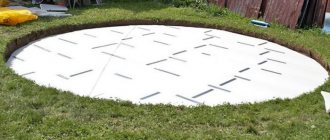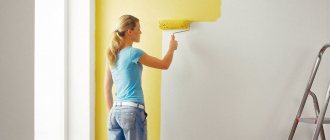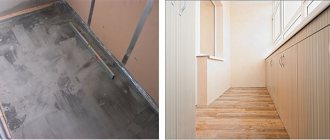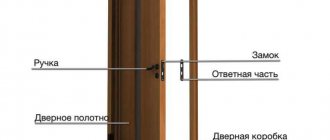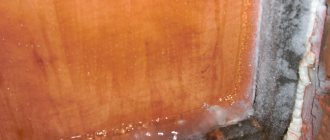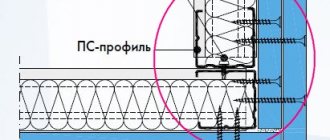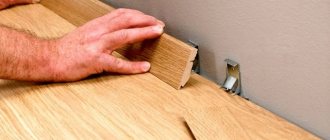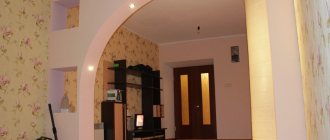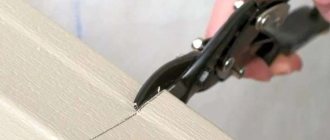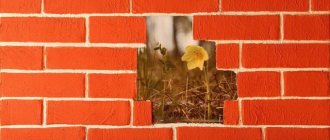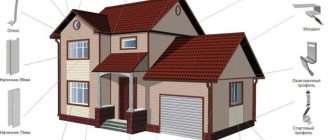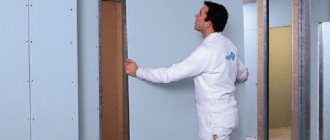Do-it-yourself podium for a frame pool + step-by-step instructions
All people who have ever dealt with an inflatable or frame pond know firsthand about the problems with periodic punctures of the PVC membrane and side breakdowns.
They try to cover and strengthen the supporting structure, and most often with varying degrees of success. It will be much more reliable and efficient to assemble the podium for the frame pool yourself. In this case, you can be sure that the structure of the reservoir will not be broken if you unsuccessfully try to climb into the reservoir or even get out of it.
You can build a podium for a pool very quickly, on average within 1-7 days, depending on the design. With a ladder and deck, using the pond will be much easier.
Introduction
Arranging a sauna pool is not the easiest task.
This is a labor-intensive task that requires not only physical but also financial investments. But all the difficulties that the master has to face will be completely justified, because a cool pool in which you can swim after a steam room is simply indescribable bliss. The peculiarity of the pool in the bathhouse is that short-term and sudden changes in temperature are very useful for the human body. This can significantly strengthen your immune system and improve your mood. But not everyone can afford a full-fledged swimming pool. This requires a sufficient amount of free space, so it is best if such an addition is planned during the construction phase. This can significantly save time and money. There are a huge number of bathhouse projects with swimming pools for every taste and budget. But they all have one important feature, namely high requirements for waterproofing and fire safety
Therefore, even at the planning stage, it is always recommended to pay special attention to the material from which the bathhouse will be built. Recently, experts are increasingly recommending laminated veneer lumber, as it has a huge number of advantages compared to other options.
Where and approximately at what cost can construction be ordered?
You can order a podium from any specialized organization involved in the construction of wood structures.
In addition, craftsmen from specialized companies can offer ready-made solutions that have been tested in practice or are of great decorative interest.
The cost of construction depends on the complexity of the design or the size of the structure. On average, such structures cost from 4,000 to 6,000 rubles/m2, although prices vary depending on the region.
Pool on the podium - why and how
Another option for the device is to create a rigid base protruding above the ground for an inflatable pool. Two simple examples: a monolithic concrete slab and a boardwalk on stilts or brick pedestals.
The higher you raise the pool, the higher the likelihood that your neighbors will become unwitting witnesses to your relaxation.
Of the special cases of high superstructures, it is worth mentioning separately the pool deck. It is assembled in a wide arc at the edge of the stationary base and rises to the level of the sides, thus the temporary pool acquires all the signs of a stationary one.
rmnt.ru
09.06.16
What tools and materials will be needed
If you plan to make a small podium around a round pool, you will need a minimum of materials:
- Pine boards at least a meter wide and 40-50 mm thick, on average at least 15-20 m.p. are required. for one runway span;
- Post beam 60x60 mm, the quantity is calculated based on the height of the pool bowl and the length of the podium path;
- Croaker and slats, diameter 50-60 mm. They will need to be used to make struts and struts in order for the wooden frame to be sufficiently rigid;
- Facing board, you will need 2-3 m2, you can use clapboard or board 10 cm wide.
To build a wooden frame you will need a standard carpenter's kit. Firstly, an electric pruning saw is a circular saw. You can use a jigsaw, but the amount of work is quite large, so it is better to use a circular saw. Secondly, you will need carpenter's corners, measuring tape and tape measure. If you plan to make a full-fledged podium around the entire pool bowl, you will need a laser level or level. Thirdly, you will need to stock up on a good cordless screwdriver and a set of batteries.
The construction process itself does not present any particular difficulties if you have at least a little experience in carpentry.
If you need to build a full-fledged stationary podium, then it is best to take the advice of experts; this is a complex matter and requires a foundation and flooring of joists. One of the options for constructing a wooden base for a pool is shown in the video:
Advantages and disadvantages of base material
Advantages:
Ease of use.- Durability, versatility. The podium is used instead of a table or as play equipment.
- Possibility of constructing a large base to use as a recreation area.
- Durable wood species can withstand heavy weight without deforming the bowl.
Flaws:
- Wet boards are dangerous for small children. On slippery surfaces, children may fall and get injured.
- The tree requires special care. The material must be coated with a protective compound to avoid rotting and cracking.
Supports
Consider the option of arranging concrete supports with a diameter of 12 inches each.
| Feet | Centimeters | Inches | Centimeters |
| 1 | 30,48 | 1 | 2,54 |
| 2 | 60,96 | 2 | 5,08 |
| 3 | 60,96 | 3 | 7,62 |
| 3,5 | 106,68 | 3,5 | 8,89 |
| 4 | 121,92 | 4 | 10,16 |
| 5 | 152,4 | 5 | 12,7 |
| 10 | 304,8 | 12,7 | 32,258 |
| 11 | 335,28 | 11 | 27,94 |
| 12 | 365,76 | 12 | 30,48 |
| 15 | 457,2 | 15 | 38,1 |
| 20 | 609,6 | 20 | 50,8 |
- According to the project, holes are dug of the appropriate diameter and a depth of about 4 feet.
- Afterwards, so-called “sleeves” made of roofing material secured with adhesive tape are inserted into these holes. They should protrude approximately 1 foot above the ground surface.
- Concrete is poured into these “sleeves”, and metal connectors are installed on top, to which wooden supports will be attached.
To avoid digging holes again, make a sketch with dimensions that will show the coordinates of each support. It’s better, of course, to do this on a site plan, especially if there are plants in the construction area or there are communications, then you won’t have to uproot a tree or repair the water supply.
Figure 2 shows the location of concrete supports (Footings), as well as their coordinates. If the support ends up on a water pipe, or if there is a tree growing nearby, simply move the support slightly to the side. It is better to calculate everything and draw it on paper rather than face unpleasant surprises during the construction process.
Figure 2. Location of supports
Having marked the location of the supports on the site, dig holes for them and concrete them. Don't forget to install post connectors into the wet concrete supports. After the concrete has hardened, secure the vertical supports in metal connectors. Use 4" x 4" cross-section posts for supports since the deck is less than 6 feet high.
Figure 3. Scheme of concrete supports
Step-by-step installation instructions
After choosing a place to install the pool, you need to mark the site.
For this purpose:
- pegs;
- roulette;
- laces.
The marking boundaries for the site should extend 0.5 m beyond the contours of the pool.
Taking into account the shape, the outlines of the base are determined:
- For a round product, a peg is driven into the soil and a rope is put on it. A can of paint is attached to the free end. Using the principle of a compass, a circle of the appropriate diameter is drawn.
- For an oval pool, two circles are drawn in the same way. The borders are then connected by parallel lines using threads.
- If the shape is a square or rectangle, you need to drive 4 pegs in the corners. Between them, threads are stretched at right angles - the sides of the platform.
Before laying the base, the area must be cleared of grass and debris, and then the soil must be compacted tightly.
Materials and tools
For installation you should prepare:
- sand (preferably river sand);
- gravel;
- water;
- cement (it is better to take frost-resistant brand F200);
- boards;
- construction trowel;
- reinforcement or solid reinforcing mesh;
- beacons made of metal profiles;
- level;
- construction mixer or concrete mixer.
A layer of geotextile can be laid at the bottom of the base. This material prevents the soil from mixing with the sand mound. Thus, the site will not sag during application.
If the pool bowl is large, it is more profitable to order a concrete machine to complete the process in one day, saving time and effort. When making the mixture yourself, you need to use cement and PGS - a mixture of pebbles with river sand.
Manufacturing process
Manufacturing stages:
After removing the top fertile layer of soil, do not throw it away. The earth will be useful for supporting the formwork in the future. Sand 10 cm high is poured onto the bottom of the site, compacted and filled with water. Get a high-density sand substrate
It is important that it is as even as possible. Gravel is poured onto the sand: the layer thickness is 5 cm. A sand and gravel cushion is created. Reinforcement or a ready-made reinforcing network is laid on top. Formwork is made along the contour - walls that limit the shape of the future concrete base
The optimal height is 10 cm. The outside of the wall should be pressed tightly with pieces of turf. Concrete is poured using a concrete mixer or mixer. The mixture should be homogeneous. It is necessary to achieve complete filling of the formwork. The platform is pierced with a metal stick to release air bubbles and increase the strength of the concrete. The surface is leveled using a construction trowel. Leave the platform until it hardens completely and remove the formwork; After hardening, the top layer is cleaned and sanded.
When installing a high concrete base, the unattractive walls of the site can be finished with natural stone.
What to put or lay on concrete?
The finished concrete site should be coated with special impregnations in order to:
- increasing durability;
- fortifications;
- preservation of appearance.
For this you can use:
- primer;
- plaster;
- waterproof paint coating.
You can cover the site:
- wooden flooring;
- polyethylene;
- a substrate, if it comes with the pool;
- linoleum;
- polyurethane insulation.
How to make a podium for a frame pool
The preparatory stage of construction is minimal, and you just need to remove all the debris, cut off weeds and uneven areas on the site, transfer materials and tools, and then you can start working. The first thing that is important to do is to tie the lower frame level with 4 pieces of timber. This is done so that under load the podium does not move away from the pool bowl when walking along the steps. The laid out bars are connected to the frame with polypropylene clamps, and pegs are driven into the ground near all sections to a depth of ¼ meter, and then tied to the strapping bars to limit vibrations or small movements under loads.
Making a wooden podium for a frame pool
In a new stage, a pair of massive bars are mounted at the ends of the laid out trim of the lower level, and they must intersect at right angles to each other. At the intersection and at the ends, the bars are sewn together with self-tapping screws. Afterwards, vertical posts in the amount of 4 pieces are installed along the walls of the pool. They are also tied together using timber material, and such a frame part is considered to be loaded to the maximum, and therefore it is better not to save money and make all timber elements with a cross-section of 6*6 cm. Afterwards, vertical type racks are installed on the legs of the triangle and we tie them with horizontal timbers. All elemental connections at the podium are made only with self-tapping screws and exclusively at an angle to the surface of the material.
Essential elements
When the base of the podium has been built to the round bowl of a frame-type pool, steps need to be made. For them, if there is support on the top trim, install a pair of inclined boards with a thickness of 4-5 cm, at a certain angle to the podium plane. Improvised bowstrings or stringers must be sewn to the top and bottom of the base of the podium frame. Lifting the ladder onto the pool bowl should be as safe as possible, and therefore you should not save money - the more spacers and struts you can make, the better.
Finishing
If the external cladding of the podium is not of particular importance, then the frame can be left in its original form, and the finishing is only to cover the wood with drying oil or varnish.
Typically, in a podium structure, the vertical frame walls are covered with wooden slats or a decorative PVC film is used. In this case, vertical slats are sewn onto the frame and the membrane is stretched, like a film for a greenhouse or greenhouse.
A frame pool on a podium in a dacha needs to be finished like this - the canvas is also laid on a horizontal surface. There is no point in leaving the tree without cladding; under the influence of the sun and moisture, the boards will quickly become covered with cracks. The steps are finished with separate pieces of canvas so that any water that gets on the stairs can flow without obstacles into the soil and the cracks between the steps.
How to make a podium from pallets yourself
Building a deck near a frame pond looks much simpler than in the first case. The podium can be assembled in the form of wide and long steps, which are covered with planks, or simply laid and knocked down from whole pallets into a couple of tiers. To get a sophisticated design, it is better to make it using knitting methods. The pallets are tied in pairs with steel wire inside the blocks, and then laid on the ground in the form of a podium and additionally sewn together with screws and slats. The front podium part is sewn up with dies that are sanded or decking boards.
Making a podium from decking boards
Building a deck in this case will not be any different from building a frame made of lumber. The only difference is the high price of terrace boards, and therefore they are used only for finishing frame steps and paths. If you plan to complete the finishing of the terrace board podium, then it is better to pre-mount the frame for the pool on homemade foundation blocks. All wooden extensions without a base are not the most rigid, and this method will significantly reduce the deformation of the podium from loads. If everything is done correctly, then regardless of the height and size of the pool, the frame will be very rigid, and none of the deck boards will rise or begin to move away from the base.
Making a podium on a slope
Quite often, a bowl for a pond needs to be placed on an area with a very noticeable slope on the surface. It is impossible to install the pool frame on a slope at an angle, and therefore it is important to plan the site and make it horizontal. The frame should be made of boards, and it is important to make the podium with steps. If the dimensions of the pool are very large, then it is important to make a pit with a depth of 0.4 meters and always with a perfectly flat bottom along the horizon. In this case, the podium for the pool can be made of a pair of small tiers placed along the steps along the perimeter of the bowl.
Maintenance and care
The maintenance procedure requires access to the site. This is problematic if a frame pool is installed on it. Typically, maintenance is carried out in the spring, before installing the structure.
However, if signs of plane disturbance, visually observed distortions or subsidence appear, the water is drained, the structure is removed to the side and the site is restored. Methods are used depending on the material and structure of the base.
If the paving slabs have sagged, lift the problematic elements and add sand. Damaged polystyrene foam is replaced with another material, etc.
Advantages of frame structures - why choose them?
Seasonal pools based on a reliable frame are ready-made factory containers made of durable plastic and reinforcing metal elements. The inside of such structures is covered with a special film. It has high strength indicators. And its surface, due to treatment with special compounds, acts as a water disinfectant. Factory-produced frame tanks have the following advantages:
- quick and trouble-free assembly (easy to do with your own hands);
- affordable price;
- ease of water replacement (usually used liquid is drained through a hose into the garden);
- easy operation;
- easy cleaning of the bottom of the structure using a hand-held vacuum cleaner and an ordinary pump;
- their kit often includes pleasant additions - pool skimmers, professional chemical kits, and so on.
What can a platform be built from?
At first glance, it is easiest to build a podium from brick and concrete; in practice, such a design turns out to be too complex and requires a solid foundation and backfilling of the soil cushion.
Important! If the steps of the ladder can somehow be built next to the bowl of the reservoir at minimal cost, then it is impossible to assemble a path parallel to the upper edge of the pool without special brick racks and a reliable foundation. The result will be a monumental structure that will be more of a nuisance at the dacha than a delight with its presence.
It is best to make a frame from a wooden beam
A small swimming pond is usually assembled during the summer season, after which the pool is disassembled and transferred to storage. The wooden parts of the podium can be made stationary or also collapsible.
You can make a pool deck on racks made of pipes, metal or asbestos-cement. Such a structure will be much more practical than a concrete one, but it will still be quite difficult to make it collapsible. In addition, under such racks it will be necessary to pour pillows and form installation sleeves. All this is quite expensive and not very practical.
Pipe base will support any size deck
The easiest way to build a frame pool podium is from wood. Any lumber available at the dacha will be used - scraps of timber, remnants of slatted cladding, lining and even pallets. The latter are considered to be the most promising material; making a podium from pallets will not be difficult, even without disassembling them into planks.
What materials can it be built from?
A homemade podium can be made from different materials, including:
- wood (boards and bars from different types of wood);
- pallets;
- terrace board (WPC);
- paving slabs;
- concrete structure.
Often combinations of several materials are used - for example, wooden flooring on a metal frame or paving slabs on a platform made of wooden elements.
There are no special requirements in this regard; the owners independently determine the degree of strength, stability and durability of the structure.
Requirements for a swimming pool site
To choose the right location, think in advance about how the pump and lighting equipment will be connected, and where the drain will be located. The requirements that we list must be observed, including for frame pools.
- The place should be level, without changes in height, slopes, or potholes. This is necessary for uniform distribution of water and durability of the structure. The maximum deviation is 2-5 mm per square meter.
- Small stones, driftwood below, construction waste, and remnants of the root system (it quickly grows again) are not allowed.
- The soil at the site where the structure is installed must be compacted tightly. Preferably with gravel.
- It is better to place the platform or pit at a sufficient distance from the house and other buildings so that in the event of damage to the system, the foundation will not be flooded.
- Do not place the base for the bowl next to trees or bushes. The water will become polluted faster.
- The place under the destroyed building is not suitable for the podium. There may be cavities left in it, which will contribute to rapid destruction.
- Also, do not use foundations intended for other objects. It has different characteristics and this will affect the stability of the tank.
- The soil should not be loose or creeping; river cliffs and places near a railway or highway are not suitable.
Let's summarize
When choosing a site, it is important that it is level, cleared of all kinds of debris and plants. It is advisable that the soil be compacted, outbuildings and residential buildings, wires, trees, and roads should be far away. It is better to build it in a sunny or half-shaded place that does not block the passage for people
Instagram @ideiipodelkidliadachi
Instagram @dnevnikmaikla
Along the perimeter, the platform should be larger than the tank itself. So that the water that splashes out of it does not form a puddle. We'll tell you what you can use to make a platform or podium for a swimming pool at your dacha with your own hands.
Base materials
The tank can be installed on ground covered with film or sand drainage (SGD). But such a foundation will not be reliable. It would be better to strengthen it. Here's how you can do it.
- Concrete or sand-cement mixture. Durable, moisture-resistant screed does not dry out over time. It is easy to obtain a smooth surface of any shape. Suitable for both removable and stationary pit pools. An excellent option for large areas.
- Boards. Easier to handle material. It’s also easy to get a flat area, but without maintenance, boards can dry out, swell, and rot.
- Decking (terrace board, garden parquet). Wood-polymer modules that do not require special processing. Decking is not afraid of rain and snow - it will not dry out or rot. Laying garden parquet can be difficult; it can fade in the sun or float in the heat.
The photo shows options for different platforms.
Instagram @khayakdolf
Instagram @gvk2008
Instagram @vintovayasvaya
So, the place and materials have been chosen. Now you need to prepare the area.
Podium made from decking boards
Another design option is a frame pool with a podium made of more expensive and durable material - deck boards. It does not rot, does not fade, is easy to clean and has an anti-slip surface. It has different colors and textures. In any case, such a podium will fit beautifully into any interior. The decking board can be laid independently, using stainless steel screws or wooden logs. And be sure to leave gaps between the boards at a distance of 1 cm. So that the tree can breathe. Nowadays, decks made of artificial materials are used, which do not require additional treatment to prevent rotting and can be secured with a secret lock.
If you are planning a podium for an inflatable pool that will serve as a Jacuzzi, then the structure should be of such a height that it is convenient to hide the entire filtration, pumping and heating structure. And convenient access in case of repair and maintenance.
IMPORTANT! You should not use plans for ordinary podiums, which can easily be found on the Internet for placing outdoor spas. They are designed for a load of about 18 kg/sq.m., and an outdoor Jacuzzi gives a load of about 400 kg/sq.m. Carefully double-check and recalculate all numbers, taking into account the size and weight of your hot tub.
steps
The next step in building a wooden deck is to install the frame for the steps. The basis is the stringers, which are located at a distance of 16 inches from each other.
Scheme of stringers
To make them, use a board with a cross section of 2x10. In order for all the steps to be the same in length and height, you first need to make a pattern for one step, and then sequentially mark the steps on the blank for the stringer.
Stair stringer is a sawtooth-shaped wooden board or beam with rectangular teeth
There are, of course, non-standard sizes of steps, but most often they are made within the limits given above.
At the bottom, all stringers are connected by one board for stability of the structure. Figure 7 shows the frame of the terrace and steps.
Figure 7. Frame of the terrace and future steps
Service
The podium is cared for by treating the surfaces with protective compounds and impregnations . The first treatment is carried out before installation to prevent rotting and fungus formation.
Insecticide compositions are applied to wooden coverings, which increase resistance to damage by insects. Water-based solutions that penetrate inside are well suited for this. The effectiveness of the drug depends on the method of application.
Correct processing is carried out in the following order:
- Cleaning, leveling the surface, removing resin.
- Coating the wood with a brush or roller in 2 or more layers. When working, you must wear gloves.
- Dry the surface naturally.
POOL WITH YOUR OWN HANDS
Next to the bathhouse, I dug a hole of the required diameter, its bottom was made at a slight slope towards the center (photo 1) like a funnel, so that when pumping water from the pool, the pump could be installed in the center.
EVERYTHING YOU NEED FOR THIS ARTICLE IS HERE >>>
The sandy bottom was covered with foam plastic (polystyrene), then polyurethane foam slabs were laid on it. The latter were connected to each other with tape (photo 2) on a fabric basis. Then covered it with geotextile.
From painted metal sub-wood (bought at the building materials market) I assembled the edge of the pool. Then I covered the bottom with penofol so that its edges slightly overlapped the wall of the pool (photo 3). The result was a soft bottom, which is very comfortable when swimming.
I attached a plastic insert around the perimeter and filled the pool with water from the well (photo 4)
What types of swimming pools are there - a short overview of the designs
For personal use, indoor and outdoor pools with small geometric dimensions are usually used. The first ones are installed inside any buildings, the second ones - outdoors. Installation of very small structures, called mini-pools, is allowed even in the basements of high-rise buildings or in large apartments. Experts divide the structures described in the article into three types:
- Inflatables are the simplest pool option. It is easy to transport. Such structures can be easily installed on any horizontal site, be it an asphalt road leading to a garage, or a concrete path to a residential building.
- Stationary - complex structures equipped with treatment systems, equipment for filling the bowl with water, and so on. Their installation is carried out in special rooms - in pool pavilions with an open or closed top. Also, stationary bowls are installed directly in the courtyards of country houses. In this case, no structures are built for them.
- Seasonal - the most popular designs used in the warm season. They are made on the basis of a special frame, which guarantees quick assembly of the bowl in the country. As a rule, a frame pool is placed directly in the open air and is used exclusively in the summer. Sometimes such structures are installed in covered buildings - galleries, the walls and upper part of which are made of translucent materials.
A frame pool has many operational advantages. We will talk about them in more detail below.
Requirements for a swimming pool site
To choose the right location, think in advance about how the pump and lighting equipment will be connected, and where the drain will be located. The requirements that we list must be observed, including for frame pools.
- The place should be level, without changes in height, slopes, or potholes. This is necessary for uniform distribution of water and durability of the structure. The maximum deviation is 2-5 mm per square meter.
- Small stones, driftwood below, construction waste, and remnants of the root system (it quickly grows again) are not allowed.
- The soil at the site where the structure is installed must be compacted tightly. Preferably with gravel.
- It is better to place the platform or pit at a sufficient distance from the house and other buildings so that in the event of damage to the system, the foundation will not be flooded.
- Do not place the base for the bowl next to trees or bushes. The water will become polluted faster.
- The place under the destroyed building is not suitable for the podium. There may be cavities left in it, which will contribute to rapid destruction.
- Also, do not use foundations intended for other objects. It has different characteristics and this will affect the stability of the tank.
- The soil should not be loose or creeping; river cliffs and places near a railway or highway are not suitable.
Better
Along the perimeter, the platform should be larger than the tank itself. So that the water that splashes out of it does not form a puddle. We'll tell you what you can use to make a platform or podium for a swimming pool at your dacha with your own hands.
Pool areas
The main condition for making a pool podium is the choice of location and its preparation.
- This should be a perfectly flat surface on the site.
- There should be no trees or bushes nearby, as this will cause additional debris in the pool. And the root system will eventually destroy the cushion and damage the walls of the pool.
- There must be running water nearby.
- The reason to prepare carefully. The size of the podium is measured. The top layer of soil is removed. It is filled with sand and compacted. The formwork is being built.
Why is a podium needed:
- The podium, first of all, is necessary to protect the film coating of the pool from damage.
- Secondly, it is a screen that hides the unsightly appearance of the pool maintenance system. And protects it from precipitation and overheating.
- Thirdly, it is aesthetic in nature and transforms the site.
- Fourthly, it is an additional place to rest, comfortable, flat, without sand, grass, and stones.
- Fifthly, having a foundation, it is more convenient to organize a canopy for a pool at the dacha - with your own hands or with the help of professionals.
Wooden terrace for a frame pool
Pool design on a podium
Pools can be built-in or free-standing. The latter option has a staircase for entry. The pools on the podium look impressive. They fit perfectly into the landscape design or interior of the room. The bowl is built into a podium, which is decorated with mosaics, ceramic tiles, marble or natural stone. The standard set of equipment for swimming pools with hydromassage function includes:
- frame;
- overflow grate;
- piping;
- nozzles;
- overflow tank;
- pump;
- filtration, heating and disinfection system.
The bowl is usually made of acrylic. Depending on the model, a certain number of nozzles of different sizes are placed. An integral part of the design of swimming pools are filters for water purification; the frequency of its replacement depends on their quality. The presence of an ozone generator improves the quality of the liquid by an order of magnitude. In hydromassage pools, there may be an option for air massage, aromatherapy and countercurrent.
Rating of quality pavilions for swimming pools for 2022
With round base
3rd place: Poolmagic PH-03
Manufacturer: Poolmagic. Mobile, single-section, for a round pool. Parameters (length, height, width): 6x2.8x5.2 m. The body is made of polyester, the structure itself is made of fiberglass or galvanized steel. With three doors with zipper or lock. Suitable for protecting water from dirt and dust, can be used as a gazebo.
pavilion Poolmagic PH-03
Advantages:
- Looks stylish;
- Easy to install;
- Long service life;
- High quality material.
Flaws:
2nd place: AZURO
Costs 120 thousand rubles.
Mobile, with one section. Weight – 60 kg. Dimensions (LxHxW): 4.9x2.6x4.9).The cover is used for above-ground and in-ground pools. The skeleton is tubular aluminum with a protective layer against ultraviolet radiation. With a movable roof.
pavilion AZURO
Pros:
- The structure is easy to move;
- Easy installation;
- Waterproof;
- Can be used for recessed hot tubs.
Minuses:
1st place: Aluten Elite
Price: 445 thousand rubles.
Russian made. Dimensions (LxWxH): 4x4x2 m. Modern frost-resistant model, does not require disassembly before the start of the winter months. The production uses a special anodized coating technology. The special composition protects the structure from external factors.
Aluten Elite pavilion
Advantages:
- With rubber seal;
- With anti-corrosion layer;
- Stylish design;
- Strength of the structure.
Flaws:
With oval/rectangular base
5th place: AZURO
Sold at an average price of 200 thousand rubles.
Manufacturer: Mountfield. Mobile, oval shape. The number of sections is three. Dimensions (LxHxW): 10x4.1x2.2 m. Weighs 104 kg. Made from a tubular aluminum “skeleton” with a rising roof.
pavilion AZURO
Advantages:
- High-quality material – VALMEX textiles;
- UV resistant;
- Simple and quick assembly;
- It is possible to open the bathhouse from all sides.
Minuses:
4th place: NOVUM-CLASSIC A
Price: 437 thousand rubles.
Rectangular vaulted model. Not afraid of temperature changes and climatic influences. Stable structure with three supporting profiles made of aluminum alloy AlMgSi and polycarbonate cells.
pavilion NOVUM-CLASSIC A
Advantages:
- High quality material;
- With removable front plane;
- Lasting;
- Anodized coating;
- Warranty: 2 years.
Flaws:
Bronze: Carat
Cost: 328 thousand rubles.
Brand VOEROKA. Rectangular model made of AlMgSi aluminum profiles and cellular polycarbonate with UV and corrosion protection. Three-section. There is a roller mechanism.
Carat pavilion
Advantages:
- Door with lock;
- With semi-automatic bolts;
- Movable sections;
- With anti-corrosion coating;
- Long service life - 25 years.
Minuses:
"Silver": AVRORA
The average price is 500 thousand rubles.
Manufacturer: Cascade. Parameters (LxWxH): 8.25x4.5x0.94 m. A four-section low model made of cellular or monolithic polycarbonate is used to protect water. A mobile shelter allows you to open the pool completely on a clear day and close it in bad weather.
pavilion AVRORA
Advantages:
- Practicality;
- Quality materials;
- Elegant appearance;
- With movable sections.
Flaws:
- Cannot be used as a canopy for relaxing near the water;
- Expensive.
Alternative
Other types of heat insulators are recommended that can perform the same functions:
- Styrofoam. It crumbles and requires laying a hard sheet layer (plywood or chipboard) on top, but otherwise the material can serve as a base for a pool.
- Izolon. This is foamed polyethylene. Rigid varieties with high density differ little in their qualities from penoplex.
- Technoplex, Stirex, Extrol are types of polymer boards whose parameters are similar to penoplex.
- Arbolit. A mixture of wood chips and cement mortar. It has high strength, but is not resistant to water.
- Foam glass. This material retains heat well and is highly durable. However, it is expensive and rarely found on sale.
All materials have their own specific characteristics, so you need to choose carefully, taking into account all the features and factors.
Why is it better to use frame containers if the soil is unstable?
The main positive side of frame tanks is the possibility of their independent construction. How to make a base for a frame pool and a podium for a pool with your own hands? Quite simple - use separate panels and high-quality waterproofing. It is necessary to tightly tighten the wall and floor elements so that the frame can withstand high internal pressure.
But it’s faster and more reliable to buy a ready-made “constructor set”, which is based on steel elements. This design is reminiscent of load-bearing walls of buildings. The inside of the tank is covered with a heavy-duty film with an additional layer for water disinfection. This pool:
- fits into any design;
- folds quickly;
- acceptable price;
- meets the main needs of buyers;
- works well;
- the water circulation system is so simple that anyone can handle it - just drain the water with a hose;
- The bottom is cleaned using a conventional pump or vacuum cleaner.
The bottom of the pool is cleaned using a special vacuum cleaner.
The stand with the pool remains outside in the winter only in cases where the elements of the tank are made of frost-resistant materials. But such designs are expensive.
High maintenance costs and difficulty in maintaining are the main reasons to choose a smaller tank. It’s better to do everything for the pool yourself.
Which base for a frame pool is better?
In order for the decking under a frame pool made by yourself to last as long as possible, it is recommended to adhere to the following points:
- A correctly chosen place for an artificial pond is located near the water supply system, on the sunny side of the plot. Summer leisure for both adults and children is better spent in comfortable conditions for swimming. The optimal site parameters range from 16 sq. m.
- If you use a foundation pit for a font, then its area should be 4x4 m. It is not recommended to go deeper than 2 m; a depth of 1.5-2 m is quite sufficient. The configuration of the tank can be any.
A high-quality foundation is the key to a long service life of an artificial reservoir made of polymer materials. Important!
It is necessary to dig a pit for arranging a pool, taking into account the waterproofing layers, increasing the dimensions by 40-50 cm. The base can be of a surface type:
- On the podium. To make it, wood is used, which must first be treated with protective agents. Such a unique deck can also be built from concrete. A frame pool made of polypropylene is installed in the prepared holes.
- On the ground. The base can be concreted, polystyrene slabs laid on the bottom, and a rubber platform made.
The best foundation for an artificial pond meets the following requirements:
- the bowl stands steadily on the prepared surface;
- any tilting of the tank is excluded;
- high quality of work performed.
The main thing is that the frame-type artificial pond does not move from its place during use. The platform must be strong and reliable.
Can a frame pool be placed on grass?
If you do not prepare the surface for a frame pool, but install it directly on the lawn or grass, then it is unlikely that you will be able to avoid negative consequences. Large structures will begin to sag unevenly, causing deformation. In addition, near the sides of the bowl it will always be wet, slippery and dirty. Only those tanks that can hold no more than two tons of water can be installed on the grass.
Economy option: swimming pool from a banner
If you need an express option for a pool at minimal cost, you can get by with a thick film. For example, an old banner. The fabric used for them is thick, and you can buy an old one at an agency for mere pennies. If you need a pool in your garden, this is exactly the material: the costs are minimal.
So, armed with a banner, we dig a pit, which is significantly smaller in size than the canvas.
We lay out the banner in the pit
We lay the film in the dug pit and straighten it. For testing, a small pit was dug in case it wasn’t to his liking. Since the banners were old, after all, they laid two. They also tried to straighten the second one.
The second banner was laid on top
To prevent the edges of the film from being blown away by the wind, they were pressed down with bricks and a hose was thrown in to collect water.
They threw a hose
While the water was being collected, a little earth was poured around the “bowl” under the film, forming sides. They were lined with bricks.
While water was being collected, the edges were pressed with bricks
We left the “pool” to bask in the sun. Three hours later the tests were carried out. I liked the result. It was decided to expand the “swimming” part.
Testing a pool at the dacha
This, of course, is not a great option, but you can freshen up. It took 2 hours for “construction”. The main thing is to dig a pit. And what happens next is a matter of several tens of minutes. The photo below shows the same idea implemented on a larger scale. We bought the film for swimming pools and soldered two pieces together to create a more voluminous “sea”.
Larger film pool
Here, by the way, are several country pools made from scrap materials: an excavator bucket and a huge tire.
A long-lasting pool at the dacha is easy))
Gorgeous!
Step-by-step instructions for making a wooden pool podium
A swimming pool on the site of a country house or private house needs a durable and user-friendly design. This is especially important for framed or prefabricated structures, where the sides are not strong enough and can be accidentally damaged.
One of the most successful options is a podium that can create a convenient entrance to the water, the ability to comfortably relax near the pool and ensure the safety of the bowl and supporting structures.
To build a podium for a pool, you can use different materials, but it is most convenient to make a structure from wood.
Choose your location wisely
After choosing the type of pool, we begin to take a closer look at our site and choose a place for the future home pond. Selection criteria are suitable for any type of frame pool:
- Proximity to water supply.
- Possibility of draining water through communications or into the drainage compartment.
- Comparative distance from the house and remaining buildings.
- Comparative distance from the fence.
- Sunny side of the yard.
- A flat surface of the yard area or the ability to level it.
- A convenient location for you so that it does not interfere with movement around the yard and does not block the path to plantings, a summer kitchen, etc.
- Possibility to arrange the area around the pool, making a kind of recreation area.
The choice of location should also have an area 20 cm larger than the size of the pool base. If there is no such free space, then consider either installing a smaller pool, or freeing up your area for the selected large frame pool.
How to choose a shape and configuration?
The choice of podium configuration is determined by several factors:
- Size, bowl shape.
- The location of the pool, the availability of free space near it.
- The personal taste of the owner, his aesthetic preferences.
There are different design options:
- a ring around the bowl with a platform for sun loungers and a walkway;
- a platform adjacent to one side of the bowl;
- a complex configuration structure made on several levels (the height of the platform and the bypass path differ from each other, and there are several platforms - 2 or 3).
How to prepare the site for installing the bowl?
The base for an inflatable pool is prepared as follows:
- We choose a place to install the structure. To do this, you need to make a plan of the site, allocate an area for recreation and children's games, and determine the most convenient place for the pool.
- We measure the area of the inflatable pool in working condition and outline the boundaries of the substrate area. For comfortable use of an inflatable pond, it is recommended to add at least 50 cm to the pool area. Large designs require an increase in the substrate relative to the diameter of the pool bottom by 1 m.
- We determine the presence of an angle of inclination.
To do this, you will need to drive a peg into the expected location of the center of the pool and tie the simplest building level to it (this can be done with a rope or tape). Having carefully examined the area, we find its lowest point, which will be a guideline when measuring the slope. Now you need to move the measuring structure in a circle. If a slope is detected, it is necessary to remove excess soil and level the surface. It is not recommended to add soil to low areas. Water has significant weight, so over time, the place where the bedding was made may sag. Only minor holes can be filled (by carefully compacting them). - We clear the site. If there is no desire or need to remove the soil layer, then the inflatable pool is installed on the grass. Before this, you need to remove branches, sticks (including small ones), stones, dry growth, and roots protruding from the ground.
- We lay the substrate. The substrate finally levels and strengthens the area, prevents the soil from being washed away by splashing water, and fixes the surface.
How to prepare and level the site for a frame pool
Preparing the soil for a frame pool involves clearing it of debris and vegetation, removing the top layer and laying a sand and gravel cushion, compacting it. The algorithm for performing the work is as follows:
- Mark the site in accordance with the dimensions of the frame pool, but adding 30-40 cm to the actual dimensions of the swimming tank. If it is a round bowl, then you need to stick a peg with a long rope in the center of the area, and use the second one to draw a circle. If the structure is oval, then draw two circles along the edges, which are then connected.
- Remove the top layer of soil, going 10-15 cm deep. At this stage, you need to remove the roots of perennials, branches, stones and other debris.
- Pour a layer of river sand, the thickness of the layer is also 10-15 cm. Then pour it with water from a hose with a sprayer for better compaction. It is more effective to compact sand using a long board or a metal profile, rotating it like the hand of a clock. It is more convenient to perform this manipulation with a partner. You can make sure that the base is level by using a building level, which is laid on a profile or board.
- Lay reinforced film on the leveled area. You can put a piece of old linoleum or geotextile under the frame pool.
Advice! To level the sand layer, it is effective to use construction beacons and pegs of the same height.
How the foundation is constructed
Site preparation
After the location for installing the bowl has been selected, the area is marked out where the surface layer of soil overgrown with grass (turf) will be removed. To do this, use pegs, laces, a tape measure and a special can of paint for marking lawns. The boundaries of the prepared area should extend approximately half a meter beyond the contours of the pool bowl.
A damper pad made of polystyrene sheets eliminates the deformation of the base due to thermal expansion of the pool tank. Source housedb.ru
Depending on its shape, several methods are used to determine the boundary of the base:
- for round ones, a peg is driven into the ground (in the planned center of the structure), and a cord is put on it in a loop. A paint cylinder is tied to the second end of the thread, then a circle of the required diameter is drawn using a compass;
- in the form of a capsule, two circles are drawn in a similar way, which are connected by two parallel tangents (two threads are pulled);
- in the shape of an ellipse, three circles are outlined, which are then joined by curves “by eye”, drawn using a coloring aerosol;
- for square and rectangular ones, 4 pegs are driven in between which 4 threads are pulled at right angles for intersecting sides. Right angles are formed either using a theodolite (a geodetic instrument) or using strings by calculating the sides of a right triangle (hypotenuse and legs).
When you don't have the necessary tool at hand to mark the boundaries of the base of a square pool, you can use the Egyptian triangle rule. In correctly set angles, the hypotenuse will be equal to 5 m. Source bankfs.ru
The turf within the outlined boundaries is removed using a sharp bayonet shovel, which is stuck into a full bayonet. This is a physically difficult, but high-quality and effective method. It leaves a fairly smooth surface. The turf itself can be moved to another place and used to form lawns. Additionally, to prevent the grass from germinating again, the soil is treated with biological products.
Base structure
After preparing a certain area of the site for arranging the foundation for a frame pool, the formation of a sand and gravel hard and even cushion begins, it is carried out according to the following algorithm:
- A dry mixture is prepared from a sand-gravel mixture and cement (grade 300) in a ratio of 10:1. An alternative to cement can be friable light clay, and the ratio of the components must be changed to 10:1.5;
- the mixture is poured onto the surface in an even layer of 4-5 cm, trampled down and leveled using a strip to which a level is attached. If somewhere there is not enough mixture to form a flat surface, add it, the excess is removed with a shovel;
The area for the pool made of compacted sand is leveled Source pinterest.com
- a layer of construction sand 8-15 cm thick is poured onto the leveled layer of ASG, it is also leveled and compacted;
- A damper pad is placed on top of the sand; it consists of polystyrene sheets. It is needed to prevent deformation of the sand and gravel cushion due to thermal expansion of the water container under the influence of the sun or hot water;
- the resulting multilayer “pie” is covered with a dense film (usually included in the frame container), its area should be larger than the area of the prepared base, the boundaries of the film should protrude beyond the boundaries of the site by about 1 meter. This is the final operation, after which you can begin installing the pool.
Concrete podium
ADVICE! If your outdoor pool has a large volume and is installed in a swampy area, where there are loose soils and strong seasonal heaving of the soil, then it is best to install a concrete base.
This is a more reliable and durable option. The concrete pad is also perfect as a podium for an inflatable frame pool. After cleaning the pool, the concrete area can be used as a barbecue area, relaxation area, children's playground, or simply decorated with flower pots. To create a concrete pad you will need:
- Sand.
- Cement.
- Water.
- A container for mixing the mixture or a concrete mixer.
Construction stages.
- A base is being prepared for the cement pad. The fertile layer of soil, driftwood, and stones are removed. Leveled with sand. It gets compacted. A slope of no more than 5 cm is allowed. Otherwise, there will be a load on the seams of the pool.
- Formwork is constructed from beams and boards.
- Mix the mixture in the proportion specified in the instructions for the selected brand of cement. Typically, M400 grade cement is used for structures in contact with water.
- Pour into prepared form. We are waiting for it to dry completely. If the weather is too hot, we wet the surface to prevent cracks.
- You can lay paving slabs on the finished concrete pad to match the color of the paths. You can stick on soft vinyl anti-slip tiles or simply lay a layer of polystyrene foam and awning fabric. Decorate excess edges with stones or sand.
Do-it-yourself concrete platform for a swimming pool at the dacha
Making a foundation pit
For work, frost- and water-resistant concrete of grade M100 or M300 is used. If you prepare the mixture yourself, take coarse sand, crushed stone, cement and additives to increase water resistance. The latter are sold ready-made. Conduct all communications in advance.
- Lay two layers of roofing material overlapping on a sand or sand-gravel cushion.
- Seal the joints with mastic or sealant.
- Lay another sheet of roofing material on top.
- Cover the joints again with mastic or sealant.
- Lay the reinforcement on the bricks so that you get a grid with 20x20 cm cells. Bend the ends of the rods onto the walls.
- Start pouring the mixture. The recommended layer thickness above the mesh is five centimeters.
- Level the mixture and pierce it in several places with a sharp stick so that there are no air bubbles left inside.
- Cover the bottom with film or spray it every day to prevent the concrete from cracking as it dries.
- When the bottom hardens, install the formwork on the walls. You can build it from plywood.
- Make a reinforcing mesh at a distance of 5 cm from the formwork. Tie the new rods to the ones that are bent at the bottom.
- Secure the mesh with diagonal slats.
- Pour the concrete.
- When it dries, plaster the surface.
Check if the waterproofing is done well. Fill with water, mark its level and leave for two weeks. Taking into account natural evaporation, no more than 2 cm should go away. If all is well, you can begin finishing. This is also additional waterproofing. Instead of roofing felt, you can use geotextile fabric, thick film, or polypropylene.
Instagram @ekskavatorpogruzchikizhevsk
Instagram @oazis_ul
Instagram @oazis_ul
Making a podium
For work it is recommended to use concrete M100 or M300. Hydrophobic additives, cement, crushed stone and coarse sand are added to the mixture, made independently.
- Lay overlapping sheets of geotextile, film or roofing felt on a sand or sand-gravel bed.
- Seal the joints with mastic or sealant.
- Place reinforcing mesh on the bricks with a cell size of 20*20 cm.
- Make the formwork the desired height.
- Pour concrete or cement-sand mixture (1:3) and level it.
- Pierce it in several places with a sharp stick so that there are no air bubbles left inside.
- When the mixture sets, remove the formwork and wait until it dries completely.
- Cover the surface with plaster, primer and, if desired, waterproof paint and tiles.
Instagram @_natashik_1804
Instagram @konakovokolodec
Instagram @svetlanaelshankina
Instagram @_natashik_1804
Preparing the site
Territory marking
There are several marking methods. In any of the proposed options, add 0.15 meters or more to the size of the structure if you plan to build a wide platform.
- Rectangular, square. Stick four sticks into the ground and stretch a rope between them so that the corners are right.
- Round. Where the middle of the tank is supposed to be, dig a post into the ground and tie a long rope to it. Tie paint in a can to its second end, and then draw a circle. Instead of paint, you can take a bottle of sand and mark the boundaries with it. Or tie a sharp stick to the free end of the rope and draw a circle on the ground. Another option is to pierce the ground, and install other pegs in place of the punctures, stretching a rope between them.
- Elliptical. Draw three or two circles and then connect them by eye using one of the methods listed above.
Instagram @family_build
- Landscape
6 useful and beautiful ideas for decorating a swimming pool on your property (you’ll want to repeat them)
Clearing the area
If you are preparing a ground area, use a bayonet shovel inside the marking to remove the turf. Stick the shovel completely into the ground - 30-40 cm. However, experts do not recommend making a hole more than half a meter. It is recommended to fill deeper holes with concrete and lay brickwork around the perimeter.
The removed turf can be used to create lawns on the site. Remove remaining roots, herbs, and stones from the cleared area. Then treat it with drugs that slow down plant growth.
For a stationary pit pool, dig a hole to a depth of 2.5 meters - if you plan to jump into the water from the side and 1.5-2 meters - for structures with steps. Use a level so that the bottom of the pit has a slope of 4 cm by 1 meter towards the drain.
Large frame tanks are always made in a small recess. This way they will be more stable, and less water will accumulate around them. This installation option is also suitable for loose soils.
Instagram @catdigger177
Instagram @fauxfarmhouseranch
Leveling and compaction
Make a 20-25 cm sand cushion at the bottom of the pit or on top of the ground. It will become an excellent shock absorber if there is a busy road nearby. Level and compact it with the help of construction beacons, a level, and rules. Tamping can also be done with a vibrating plate or ordinary water. Water the future platform several times with water from a hose and sprayer, and then level it. Sand can be replaced with ASG and cement. The ratio of components in this mixture is 10:1.
For a small tank, such a pillow is often enough. Geotextiles or thick film are laid on it, and a bowl is placed on top. If it is more than 1-2 cubes, the prepared area is strengthened using one of the methods described below.
Instagram @rspools
Instagram @liudmilachurukevich
